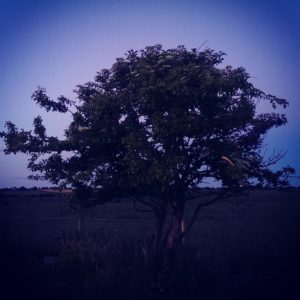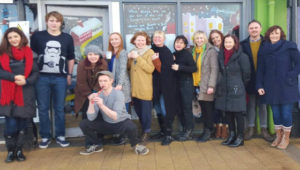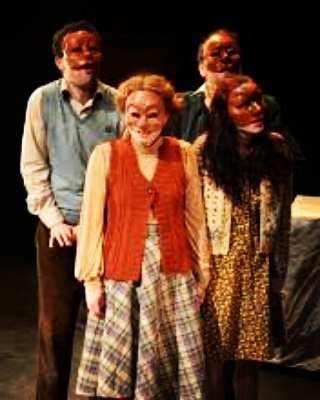 Those in the know warn that if you get too close to a faerie thorn, you risk being caught in some kind of enchantment. Before my faerie-hunting adventure, I wouldn’t have paid heed to such a warning, but now I suspect I might be caught in such an enchantment myself.
Those in the know warn that if you get too close to a faerie thorn, you risk being caught in some kind of enchantment. Before my faerie-hunting adventure, I wouldn’t have paid heed to such a warning, but now I suspect I might be caught in such an enchantment myself.
At the launch of The Faerie Thorn and Other Stories in September 2015, I spoke about how I had fallen asleep near a faerie thorn on our farm and woken up with a story in my head. I spoke about how I had written down the story in seven days and how I had sent it off to Blackstaff Press just for the adventure of it.
Getting the publishing deal with Blackstaff was the perfect faerie-tale ending. I was completely thrilled – and if the magic had stopped there, I would have been happy enough. But it didn’t stop there.
Within a month of publication, I was approached by Zoe Seaton, Big Telly Theatre Company’s artistic director, about the possibility of adapting some of the stories for the stage. I went to see Big Telly’s production of Gulliver to get a feel for what their brand of physical theatre was like. What I saw was witty, energetic and anarchic – and I loved it!
In November I met with Patsy Horton, managing editor at Blackstaff Press, and Zoe to talk about Big Telly’s vision for the production. Patsy felt that Big Telly were a good fit for the book, and I felt like Big Telly were a good fit for me because they were keen for me to be actively involved throughout the development process.
 The first development session took place in December. Over the course of three days, seven actors stretched and pulled and prodded two of my stories. First they read The Faerie Thorn aloud in seven-voice choric chaos. They played with the tone. They played with the volume. They messed with the gaps between the words. They looked under the words and behind the words. They hurled the story and they hammered it hard – and the more they hurled and hammered it, the more ‘story’ there seemed to be.
The first development session took place in December. Over the course of three days, seven actors stretched and pulled and prodded two of my stories. First they read The Faerie Thorn aloud in seven-voice choric chaos. They played with the tone. They played with the volume. They messed with the gaps between the words. They looked under the words and behind the words. They hurled the story and they hammered it hard – and the more they hurled and hammered it, the more ‘story’ there seemed to be.
Zoe explained that testing a story like this gives an indication of the kind of theatrical ‘treatment’ a piece might suit best. It turns out that The Faerie Thorn is pretty robust: a seam of steel runs through it. It can take pretty much anything.
 The Merrow of Murlough Bay, the second story to be adapted, responded to this stretching and pulling and prodding in a completely different way, though – and I responded to the stretching and pulling and prodding in a completely different way, too. The emotional seam of the story was ripped open by this process and the seam was far too tender, far too vulnerable, for such treatment. The more the actors stretched and prodded and pulled, the greater my emotional response: I felt bruised and lonely and sad. I felt like Bright Blue – in that burning willow cage up by Lough Doo.
The Merrow of Murlough Bay, the second story to be adapted, responded to this stretching and pulling and prodding in a completely different way, though – and I responded to the stretching and pulling and prodding in a completely different way, too. The emotional seam of the story was ripped open by this process and the seam was far too tender, far too vulnerable, for such treatment. The more the actors stretched and prodded and pulled, the greater my emotional response: I felt bruised and lonely and sad. I felt like Bright Blue – in that burning willow cage up by Lough Doo.
I was more than relieved when Zoe and the actors said they had experienced the process in the same way as I had. It was clear to everyone that The Merrow was not the same as The Faerie Thorn and would need to be treated in a very different way.
Now if you’re a writer, and reading about this process makes you want to delete ‘Have my book turned into a piece of theatre’ from your top-things-I- would-like-to-happen-to-my-book list, just hold on! What I have just described may sound brutal, but what I am about to describe is nothing short of magic.
For me, the stretching and pulling and prodding process was an effective way of helping Zoe and the actors locate, and connect with, the same emotional seams from which I had mined the stories. Once that connection was made, everything changed: from thereon in, Zoe and the actors showed me the seam. Okay, the showing the seam thing might take a bit of explaining, but I’ll give it a go …
The stage adaptation is being developed using a process called ‘devising’, a collaborative approach involving the whole creative team: artistic director, actors, writer, composer, technicians – the lot. It’s an exciting process and often looks, and feels, like play. During the first development session, Zoe suggested that the actors wear half-masks (the lower half of the actor’s face remains uncovered) and do some devising work with the trolls from The Faerie Thorn.
 Now where there’s a half-mask, there’s always anarchy, and as I watched the actors at play, all I was experiencing was a whirl of chaos – until that chaos turned into something that took my breath away. There, right in in front of me, were my trolls. I recognised them and they seemed to recognise me – and I was shocked. It wasn’t just the look of them that I recognised, either. It was the response they elicited in me that convinced me these creatures had come straight from the seam. They made me laugh but horrified me at the same time, just as they had when I had written them. And more than that, when I watched them, I could feel the seam in my own body resonating with what was being played out in front of me.
Now where there’s a half-mask, there’s always anarchy, and as I watched the actors at play, all I was experiencing was a whirl of chaos – until that chaos turned into something that took my breath away. There, right in in front of me, were my trolls. I recognised them and they seemed to recognise me – and I was shocked. It wasn’t just the look of them that I recognised, either. It was the response they elicited in me that convinced me these creatures had come straight from the seam. They made me laugh but horrified me at the same time, just as they had when I had written them. And more than that, when I watched them, I could feel the seam in my own body resonating with what was being played out in front of me.
For me, that was the turning point. That was the point at which I started to trust the artistic director. That was the point at which I started to trust the process. That was the point at which I started to realise how clever and brilliant actors can be. That was the point at which I understood my stories were ready to leave me – and I was more than ready to let go of them. That was the point at which I started to I acknowledge that these people could work some kind of magic with my stories that I never could on my own.
And so here I am, nearly a year on. Since that first session, an astonishing amount of progress has been made – not only in terms of the production, but also in terms of my understanding of how theatre works, how writing works and how collaboration works. Throw some once-in-a-lifetime experiences into the mix (like working with a composer, spending time with a mask-work expert and having a cameo role in a scratch performance), and it all adds up to something that I’ll be talking about for a long while yet.
Wednesday 12 October marks the next stage in The Faerie Thorn’s life: the auditions. And you know what? That feels big – big enough to acknowledge that those stories have come this far thanks in no small part to the talent, hard work and support of both the Blackstaff Press team and the Big Telly Theatre Company team. Even though I’m sure I got caught in an enchantment when I slept near the faerie thorn, these past twelve months have taught me that it’s not just the faeries who know how to work powerful magic.
The stage production is set to tour the UK and Ireland in April/May 2017. Opening night will be Friday 21 April in the Riverside Theatre, Coleraine. For details of the tour schedule, keep an eye on Big Telly’s website.